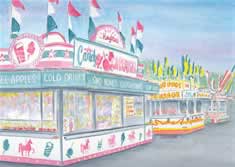 |
Cotton Candy History
 Most would assume that cotton candy came into existence in the late nineteenth century, but that's not correct. Cotton candy was actually a popular trend in Italy that began in the 1400's. The old fashioned way of making cotton candy - or spun sugar as it was called - was to melt sugar in a pan and then use a fork to make strings of sugar over an upside down bowl. The sugar would then dry in strings and be served as a dessert. This process of making spun sugar wasn't practical in the least - especially not for mass production; it was simply too time consuming. Most would assume that cotton candy came into existence in the late nineteenth century, but that's not correct. Cotton candy was actually a popular trend in Italy that began in the 1400's. The old fashioned way of making cotton candy - or spun sugar as it was called - was to melt sugar in a pan and then use a fork to make strings of sugar over an upside down bowl. The sugar would then dry in strings and be served as a dessert. This process of making spun sugar wasn't practical in the least - especially not for mass production; it was simply too time consuming.
Even centuries later, in the eighteenth century, confectioners were making spun sugar desserts and decorations. A popular favorite among Europeans were Easter eggs made from spun sugar, as well as webs of gold and silver. Generally these webs were made by the same method of using a utensil of some sort to make threads covering sweetmeats (candies without chocolate). Delicate strands covered them, creating a "web". At other times, it was made into threads over an oiled rolling pin. All in all, the technique varied slightly and required different levels of cooking skill, but the end result was nearly always the same. However, due to the amount of skill needed to create these desserts, only the wealthy usually had it. Very rarely did the average person get lucky enough to try some.
Candy makers William Morrison and John C. Wharton corrected these flaws though. In 1897 they created a machine that would melt the sugar and any flavoring and/or coloring and then use centrifugal force to push the melted mixture through a screen to create the strands of sugar. After the strands collect in a pan or bowl, they're twirled onto a paper or cardboard cone and ready to be served.
Cotton candy made one of its first world debuts in 1900 at the Paris Exposition and then again in 1904 at the St. Louis World Fair. (The Ferris wheel also was one of the highlights of this particular fair, but that's another story!) At the St. Louis World Fair, Morrison and Wharton sold boxes of "Fairy Floss" for 25 cents a box. Now, back in 1904, this was quite a bit. In fact, a box of Fairy Floss cost half the admission price to the World Fair. Despite the somewhat high price for the sugary concoction, the duo sold an astonishing 68,655 boxes ($17, 163.75 for those too lazy to do the math). About a year later, one candy store had already purchased a machine and was selling cotton candy for 5-10 cents.
Though it was at time called spun sugar and Fairy Floss, a new name for it emerged around 1920 in America. The name was none other than cotton candy. Although this is the most common name for it, cotton candy still has a few alternative names throughout the world. For example, it is called candy floss in the United Kingdom and is even still called fairy floss in other parts of the world.
By the late 1940's, one company had created a machine that would revolutionize the cotton candy industry. Then, in the 1970's, another company changed it forever by creating an automatic cotton candy machine. Not only did it make cotton candy on a mass scale, but it also packaged it automatically. Thanks to these two major changes, cotton candy can be bought in numerous stores as well as at traditional places such as carnivals and circuses.
| |
|
Written by : Linda Fri,
11 Aug 2010 |
|
|

